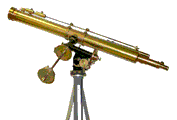Department of Physics and Astronomy: Publications and Other Research

M. Eugene Rudd Publications
Document Type
Article
Date of this Version
1949
Abstract
In student laboratory experiments in dynamics, as, for example, Newton's second law of motion or the conservation of momentum, it is, of course, highly desirable to allow motion with the least possible constraint and to observe the displacements of moving parts without using perturbing markers. This circumstance has led us to use motion pictures in the student laboratory for quantitative observation of rapid dynamic processes, a technique which is used in a well-known textbook.' The photographic method combines maximum freedom of movement with accurate observation of position as a function of time, if the camera frame speed is sufficiently high.
A double pendulum apparatus, with which we have studied the conservation of momentum in the student laboratory, is shown in Fig. 1. It consists of two wooden blocks, each suspended by a steel rod from a common free-swing pivot and counter-weighted in such a way that the center of mass of each pendulum is at the center of its wooden block. A spring is compressed between the two blocks, and they are tied together with a thread. When this thread is burned, the pendulums recoil. The mass of each block can be varied at will.
The motion is photographed with a motion picture camera at 64 frames per second. The camera used in this work was a war-surplus gun-point aiming camera, adapted only to the extent of adding a viewfinder. Since there is a coordinate screen behind the pendulums, the student can determine the heights to which the blocks rise by examining the film with a magnifying viewer.


Comments
Published in American Journal of Physics, v. 17, pp. 517-518 (1949). Copyright © 1949 American Association of Physics Teachers. Used by permission.